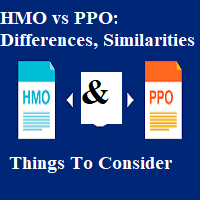HMO vs PPO has been a long-time debate between individuals when choosing a healthcare provider. The Health Maintenance Organization (HMO), and the Preferred Provider Organization (PPO) are two common health insurance plans with distinct features.
HMOs provide complete healthcare services through a network of doctors and hospitals, with members required to select a primary care physician (PCP) and acquire specialist referrals. On the other hand, PPOs provide greater freedom, allowing individuals to see any healthcare practitioner, both in and out of the network, without needing a PCP or referrals. In this article, we will discuss HMO vs PPO, their differences, similarities, and factors you must consider when choosing between them.
READ MORE: Best Health Insurance For Self Employed
What is HMO, and What are its Benefits?
Before delving into HMO vs PPO, let us answer the question, what are HMO and its benefits?
A Health Maintenance Organization (HMO) is a managed care health insurance plan that provides its members full healthcare services via a network of healthcare providers. Members of HMOs are often required to select a primary care physician (PCP) who serves as a gatekeeper for all medical services. Members must receive recommendations from their primary care physician before consulting a specialist. Here are some of its benefits:
1. HMOs often have cheaper premiums than other health insurance plans, making them more accessible for individuals and families. They also feature lower out-of-pocket costs, including copayments and deductibles, which can help you save money on healthcare.
2. HMOs provide comprehensive healthcare coverage, including preventative care, routine check-ups, screenings, vaccines, and treatment for illnesses and accidents. Members can access the HMO’s doctors, hospitals, and specialists network.
3. HMOs concentrate on coordinating all elements of healthcare within their network. Members have a primary care physician (PCP) who supervises and controls their healthcare requirements, ensuring better care coordination, faster referrals to specialists, and care continuity.
4. HMOs place a high emphasis on preventive care and wellness programs. They promote regular check-ups and screenings, which can aid in the early detection and prevention of health disorders, resulting in better overall health outcomes.
5. HMOs simplify healthcare management for members by handling paperwork, arranging appointments, and enabling communication among healthcare professionals. This simplifies the healthcare experience for members and reduces administrative burdens.
You now understand what HMO is and its benefits. Let’s discuss its rival PPO.
READ MORE: Cheapest Health Insurance In Texas
What is PPO, and What are its Benefits
A Preferred Provider Organisation (PPO) is a managed care health insurance plan that provides more flexibility and choice than an HMO. PPOs offer a network of healthcare providers, but members can also see out-of-network providers at a greater cost. PPOs have the following advantages:
1. PPOs let members choose any healthcare provider within and outside the network without needing a primary care physician (PCP) or referrals. This flexibility allows people to see specialists directly and have more control over their healthcare decisions.
2. PPOs offer limited coverage for out-of-network services, allowing members to seek care from providers outside the network. While out-of-network care may have higher prices, it provides more options and accessibility, especially when traveling or seeking specialized care.
3. PPOs, unlike HMOs, do not need members to acquire referrals from their primary care physician to see specialists. Members can make appointments with specialists immediately, saving time and streamlining the process of obtaining specialized care.
4. PPOs include cost-sharing choices such as copayments and coinsurance, which allow flexibility in managing healthcare spending. Members may also have greater deductibles and out-of-pocket restrictions. However, this is generally offset by the ability to choose providers.
Similarities between HPO and PPO
While Health Maintenance Organizations (HMOs) and Preferred Provider Organisations (PPOs) have distinct characteristics, the two forms of health insurance programs share numerous similarities:
1. Medical service coverage: HMOs and PPOs cover various medical services, such as preventative care, hospitalization, prescription drugs, and specialized treatments. Members of both plans can use their coverage benefits to obtain necessary healthcare treatments.
2. Healthcare provider network: Both HMOs and PPOs have a network of healthcare providers, which includes doctors, hospitals, and specialists. Members of both plans can choose from a network of healthcare providers to receive covered services at negotiated rates.
3. Coordinated care: HMOs and PPOs emphasize coordinated care to ensure members receive adequate and timely healthcare services. Primary care physicians (PCPs) may manage and coordinate care, make referrals to specialists, and advocate preventative care measures.
4. Pre-Existing Condition Coverage: HMOs and PPOs often include coverage for pre-existing conditions, ensuring that those with ongoing medical needs have access to critical treatments and services.
5. Utilization management: HMOs and PPOs use utilization management tactics to control healthcare costs and increase excellent care. This could include pre-authorization criteria for specific surgeries or treatments to ensure medical necessity and appropriate resource utilization.
READ MORE: Canadian Permanent Residency For International Students
5 Differences Between HPO and PPO
There are several significant differences between Health Maintenance Organizations (HMOs) and Preferred Provider Organisations (PPOs) They include
1. Provider selection: HMOs need members to select a primary care physician (PCP) and get referrals from the PCP to see specialists. On the other hand, PPOs allow members to directly access specialists without requiring referrals and offer greater flexibility in selecting healthcare providers both within and outside the network.
2. Out-of-network coverage: Except in emergencies, HMOs offer limited or no coverage for out-of-network treatments. Conversely, PPOs provide partial coverage for out-of-network treatment, giving members more choices but at a higher cost.
3. Cost structure: Compared to PPOs, HMOs typically feature lower premiums and out-of-pocket charges such as copayments and deductibles. PPOs typically have higher premiums but offer greater cost-sharing options and provider flexibility.
4. Network restrictions: For non-emergency treatment, HMOs require members to use healthcare providers inside the network, and out-of-network care is often not covered. However, PPOs have a larger network and allow members to choose providers within and outside the network at a greater cost.
5. Care Coordination: HMOs emphasize care coordination through the PCP, who coordinates and oversees a member’s healthcare requirements. PPOs allow members to self-refer to experts and provide less formal care coordination.
Things to Consider When Choosing Between HMO and PPO
There are many factors to consider when choosing between HMO and PPO. To make a good decision, consider these factors:
1. Provider preference: Evaluate your preference for provider selection. HMOs have limited networks and require a referral from a primary care physician (PCP) to access specialists. PPOs provide greater freedom by allowing you to see any provider without a referral.
2. Cost considerations: Examine your budget and financial objectives. HMOs typically feature lower premiums and out-of-pocket payments, making them more cost-effective for those on a limited budget. PPOs typically have higher premiums but provide greater flexibility and out-of-network coverage.
3. Access to Specialists: Consider whether or not you require specialized care. A PPO may be advantageous if you have specific medical concerns or require frequent specialist visits because of its larger network and direct specialist access.
4. Geographical flexibility: If you travel or live in different areas frequently, verify the network availability of both HMOs and PPOs. PPOs, on average, provide higher coverage for out-of-network care, which might be useful in such cases.
5. Preferences for care coordination: Determine your preference for care coordination. HMOs prioritize coordinated care through a PCP, ensuring healthcare continuity and oversight. PPOs offer greater liberty but may necessitate self-management of care coordination.
Final thoughts on HMO vs PPO
When comparing HMOs and PPOs, it is critical to analyze their differences, similarities, and personal variables. HMOs provide cost-effective treatment, limited provider options, and coordinated care through a primary physician. PPOs offer more flexibility, out-of-network coverage, and direct access to specialists at a higher cost.
When deciding, consider budget, provider selection, access to specialists, geographical flexibility, and care coordination preferences. Individual healthcare demands, budgetary considerations, and personal preferences for provider flexibility and care management all play a role in deciding between HMO and PPO.






